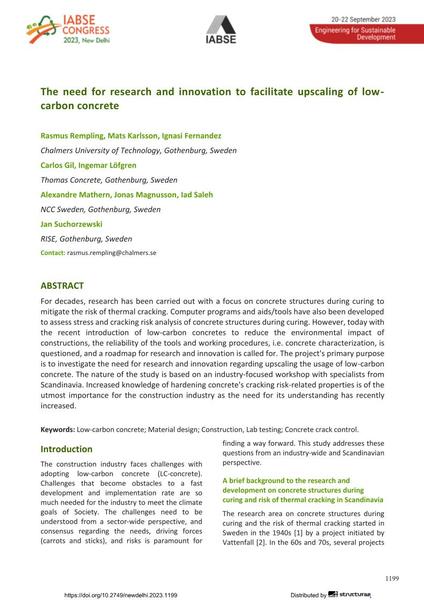The need for research and innovation to facilitate upscaling of low-carbon concrete

|
|
|||||||||||
Détails bibliographiques
| Auteur(s): |
Rasmus Rempling
(Chalmers University of Technology, Gothenburg, Sweden)
Mats Karlsson (Chalmers University of Technology, Gothenburg, Sweden) Ignasi Fernandez (Chalmers University of Technology, Gothenburg, Sweden) Carlos Gil (Thomas Concrete, Gothenburg, Sweden) Ingemar Löfgren (Thomas Concrete, Gothenburg, Sweden) Alexandre Mathern (NCC Sweden, Gothenburg, Sweden) Jonas Magnusson (NCC Sweden, Gothenburg, Sweden) Iad Saleh (NCC Sweden, Gothenburg, Sweden) Jan Suchorzewski (RISE, Gothenburg, Sweden) |
||||
|---|---|---|---|---|---|
| Médium: | papier de conférence | ||||
| Langue(s): | anglais | ||||
| Conférence: | IABSE Congress: Engineering for Sustainable Development, New Delhi, India, 20-22 September 2023 | ||||
| Publié dans: | IABSE Congress New Delhi 2023 | ||||
|
|||||
| Page(s): | 1199-1206 | ||||
| Nombre total de pages (du PDF): | 8 | ||||
| DOI: | 10.2749/newdelhi.2023.1199 | ||||
| Abstrait: |
For decades, research has been carried out with a focus on concrete structures during curing to mitigate the risk of thermal cracking. Computer programs and aids/tools have also been developed to assess stress and cracking risk analysis of concrete structures during curing. However, today with the recent introduction of low-carbon concretes to reduce the environmental impact of constructions, the reliability of the tools and working procedures, i.e. concrete characterization, is questioned, and a roadmap for research and innovation is called for. The project's primary purpose is to investigate the need for research and innovation regarding upscaling the usage of low-carbon concrete. The nature of the study is based on an industry-focused workshop with specialists from Scandinavia. Increased knowledge of hardening concrete's cracking risk-related properties is of the utmost importance for the construction industry as the need for its understanding has recently increased. |
||||
